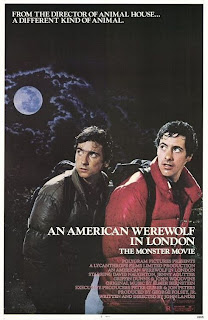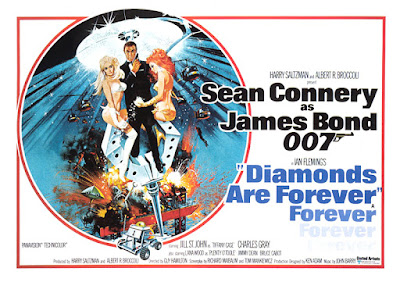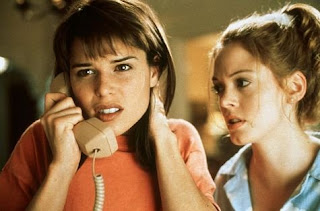Favorite Horror Films III: The Son of Sequel
Written and Directed by John Landis
 Originally written back in 1969, when John Landis was working on the set of Kelly's Heroes, An American Werewolf in London was turned down by several studio heads as either being "too funny to be a horror movie," or "too scary to be a comedy." Thankfully, ten years later, after proving himself at the box office with hits like Animal House and The Blues Brothers, Landis had garnered enough reputation and was able to bring to life a "one of a kind" werewolf movie.
Originally written back in 1969, when John Landis was working on the set of Kelly's Heroes, An American Werewolf in London was turned down by several studio heads as either being "too funny to be a horror movie," or "too scary to be a comedy." Thankfully, ten years later, after proving himself at the box office with hits like Animal House and The Blues Brothers, Landis had garnered enough reputation and was able to bring to life a "one of a kind" werewolf movie.Set in London in the early 1980s, David and Jack are two young American tourists travelling through the English countryside when they're attacked by a werewolf. What eventually ensues is a roller-coaster ride of horrific proportions that also aims to tickle your funny bone (and quite well, I might add).
Noted for its ground-breaking special effects make-up that catapulted Rick Baker's career, the film also portrays the likes of male puberty in an entirely different light and the changes one might go through if one became a werewolf. Due to it's salty language and not-so-brief-nudity (along with the blood and gore that normally comes with most horror films), this isn't a film I can recommend to just anyone. But those who are willing to endure it, will notice the creative directorial achievements of Landis, letting the audience see the beast as little as possible, the subway scene, as well as the epic and highly-coordinated car crash finale. Anyone who's my age, should also notice the some similarities of this film with Michael Jackson's Thriller video, which also happened to be directed by Landis.
Not only did the Motion Picture Academy of Arts and Sciences first recognize make-up as a category in 1981, but Rick Baker also won the Oscar (who also has since won 5 additional Oscars since then for Harry and the Hendersons, Ed Wood, The Nutty Professor, Men in Black, and How the Grinch Stole Christmas along with 5 more nominations). Although werewolves were not rare to the silver-screen, Landis' film is a landmark is cinematic history. In my honest and most humble opinion, no one has truly been able to replicate the ingenious and authenticity of Baker's make-up brilliance, including Baker himself, with the 2010 remake of The Wolfman.
Interesting Trivia:
- Studio executives hoped John Landis would cast Dan Aykroyd in the role of David and John Belushi as Jack. John Landis refused.
- During a preview of the film the marquee said, "From the Director of Animal House." Because of this, many people in the audience thought they were seeing a comedy. Reportedly, people ran out of the theater when they discovered it was a horror film because they were frightened.
Directed by John Carpenter
Written by Bill Lancaster
Remake of The Thing From Another World (1951)
 Like most of John Carpenter's films, I wasn't introduced to a majority of his work until after I graduated high school. I didn't grow up watching them, or any other kind of horror movie, when I was a kid. My parents believed, as so do I, that children shouldn't be subjected to, or have access to, certain kinds of material at such an early age.
Like most of John Carpenter's films, I wasn't introduced to a majority of his work until after I graduated high school. I didn't grow up watching them, or any other kind of horror movie, when I was a kid. My parents believed, as so do I, that children shouldn't be subjected to, or have access to, certain kinds of material at such an early age.
However, this 'golden rule of parenting' wasn't followed in every household when I was a kid, which makes perfect sense now, as I sit back and think about some of the people that I used to worked with, what they claimed that they watched at home, and how peculiar (and I'm being very kind by using this particular adjective) they ended up becoming. Let's just say that it was bad enough getting really frightened watching a specific scene in Superman III, that I can only imagine what I'd be like today if I actually enjoyed these kind of things as a child. But I digress...
The Thing stars Kurt Russell (one of Carpenter's favorite leading men), who plays R.J. MacReady, a helicopter pilot who takes charge of a twelve-man research team when an alien buried in the snow for centuries, soon thaws and wreaks havoc around them. The subtle genius of The Thing comes with the limited cast on screen. Along with the isolation of these men, the freezing temperatures of Antarctica, and the thoughts of having an alien creature imitating one of the few humans around you, works just enough by itself. But combine that with Carpenter's direction, Dean Cundey's camera work, Rob Bottin's special effects make-up, and Ennio Morricone's under-played score, and you have the perfect elements for one of the best sci-fi/horror cinematic experiences of the past three decades.
Not initially one of my favorite John Carpenter films, The Thing slowly grew on me after repeat viewings over the past few years. I now personally rank it as Carpenter's best work, followed closely by Halloween, Big Trouble in Little China, and Escape From New York. Upon its theatrical release, it was received poorly by critics and as a result, failed at the box office. Others note of it's failure at the box office were probably due to the recent release of Steven Spielberg's E.T. the Extra-Terrestrial two weeks earlier, with it's more optimistic scenario of alien invasion, as well as sharing the same release date with Ridley Scott's Blade Runner. Since then, it's become a cult classic, noted for it's ground-breaking visual and special effects make-up, and is currently listed as #165 on IMDb's Top 250 Films.
Interesting Trivia:
 Like most of John Carpenter's films, I wasn't introduced to a majority of his work until after I graduated high school. I didn't grow up watching them, or any other kind of horror movie, when I was a kid. My parents believed, as so do I, that children shouldn't be subjected to, or have access to, certain kinds of material at such an early age.
Like most of John Carpenter's films, I wasn't introduced to a majority of his work until after I graduated high school. I didn't grow up watching them, or any other kind of horror movie, when I was a kid. My parents believed, as so do I, that children shouldn't be subjected to, or have access to, certain kinds of material at such an early age.However, this 'golden rule of parenting' wasn't followed in every household when I was a kid, which makes perfect sense now, as I sit back and think about some of the people that I used to worked with, what they claimed that they watched at home, and how peculiar (and I'm being very kind by using this particular adjective) they ended up becoming. Let's just say that it was bad enough getting really frightened watching a specific scene in Superman III, that I can only imagine what I'd be like today if I actually enjoyed these kind of things as a child. But I digress...
The Thing stars Kurt Russell (one of Carpenter's favorite leading men), who plays R.J. MacReady, a helicopter pilot who takes charge of a twelve-man research team when an alien buried in the snow for centuries, soon thaws and wreaks havoc around them. The subtle genius of The Thing comes with the limited cast on screen. Along with the isolation of these men, the freezing temperatures of Antarctica, and the thoughts of having an alien creature imitating one of the few humans around you, works just enough by itself. But combine that with Carpenter's direction, Dean Cundey's camera work, Rob Bottin's special effects make-up, and Ennio Morricone's under-played score, and you have the perfect elements for one of the best sci-fi/horror cinematic experiences of the past three decades.
Not initially one of my favorite John Carpenter films, The Thing slowly grew on me after repeat viewings over the past few years. I now personally rank it as Carpenter's best work, followed closely by Halloween, Big Trouble in Little China, and Escape From New York. Upon its theatrical release, it was received poorly by critics and as a result, failed at the box office. Others note of it's failure at the box office were probably due to the recent release of Steven Spielberg's E.T. the Extra-Terrestrial two weeks earlier, with it's more optimistic scenario of alien invasion, as well as sharing the same release date with Ridley Scott's Blade Runner. Since then, it's become a cult classic, noted for it's ground-breaking visual and special effects make-up, and is currently listed as #165 on IMDb's Top 250 Films.
Interesting Trivia:
- There is a character name "Mac" and another named "Windows"; since the film was made in 1982, this is purely coincidental.
- There are no female characters in the film. The only female presence in the movie is in the voice of MacReady's chess computer and the contestants seen on the game show that Palmer watches. A scene containing a blow-up doll was filmed and then left on the cutting room floor. According to John Carpenter, only one crew member was female but she was pregnant and this forced her to leave the shoot; she was replaced by a male.
Directed by Tobe Hooper
 I honestly can't remember the first time I saw Poltergeist, but I'm pretty sure that it wasn't at my house. Now I don't want to sound repetitive, but these kinds of movies were not allowed to be viewed in my home growing up. And I'm pretty sure that they still don't watch movies like this to this day. Scary, suspenseful, or supernatural movies just wasn't my father's cup of tea. Whether it was because of his Christian faith or just because he had such a kind heart, it really didn't matter to me, so I always respected that.
I honestly can't remember the first time I saw Poltergeist, but I'm pretty sure that it wasn't at my house. Now I don't want to sound repetitive, but these kinds of movies were not allowed to be viewed in my home growing up. And I'm pretty sure that they still don't watch movies like this to this day. Scary, suspenseful, or supernatural movies just wasn't my father's cup of tea. Whether it was because of his Christian faith or just because he had such a kind heart, it really didn't matter to me, so I always respected that.
The origins of this film came from the ever-expansive mind of Steven Spielberg, who seemed to do no wrong throughout this entire decade. With terrors of a tree outside of his window and a fear of clowns that plagued the filmmaker as a child, he eventually adapted his fears along with many more, with this film as the end result. Acting also as producer, Spielberg brought on board veteran horror director Tobe Hooper, who already had success with The Texas Chainsaw Massacre and Salem's Lot.
Although Tobe Hooper is given screen credit as director, several accounts differed from actors while on the set. Hooper apparently had a laid-back directorial style and wasn't very prone to taking charge, so rumors began to spread that the film had been equally directed by both Spielberg and Hooper. However you want to read into this, there is no denying that Spielberg's genius can be seen throughout the film.
The more I've watched it over the years, the more I appreciate the brilliance in its storytelling and the filmmaker's technical prowess. Not being a person who believes in the occult, ghosts, or supernatural phenomenon, this film still strikes a chord in me today as it did the first time I ever saw it: remembering watching television late at night when it ended its broadcast day, living in a neighborhood that looked an awful lot like the one in this film, and to always be aware of what was on the land before they built your house.
Interesting Trivia:
- The shot of the chairs that position themselves in the amazing balancing act on the table was all done in one take. As the camera panned along with JoBeth Williams, who was getting some cleaning materials, several crew members quickly set an already organized pyramid of chairs on the table, then took the single chairs away before the camera scrolled back.
- JoBeth Williams was hesitant about shooting the swimming pool scene because of the large amount of electrical equipment positioned over and around the pool. In order to comfort her, Steven Spielberg crawled in the pool with her to shoot the scene. Spielberg told her, "Now if a light falls in, we will both fry." The strategy worked and Williams got in the pool.


Comments
Post a Comment